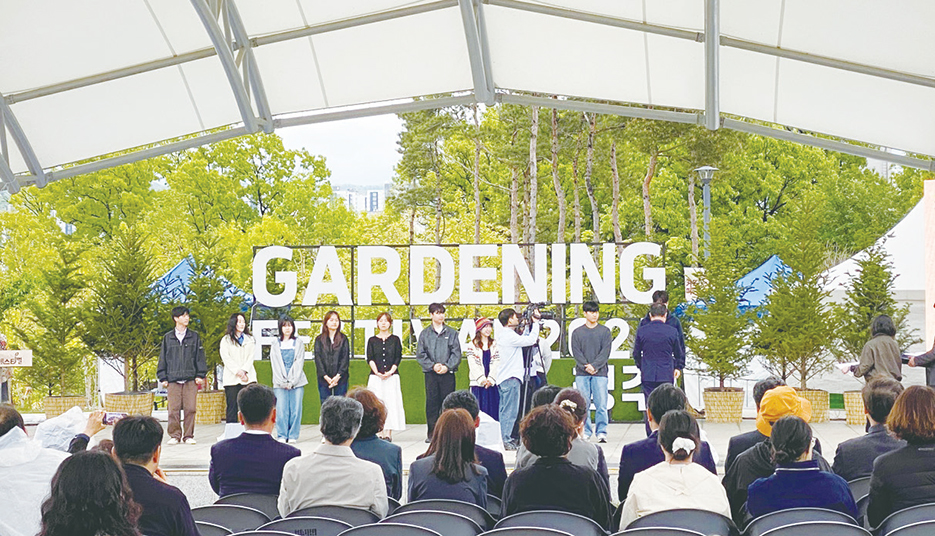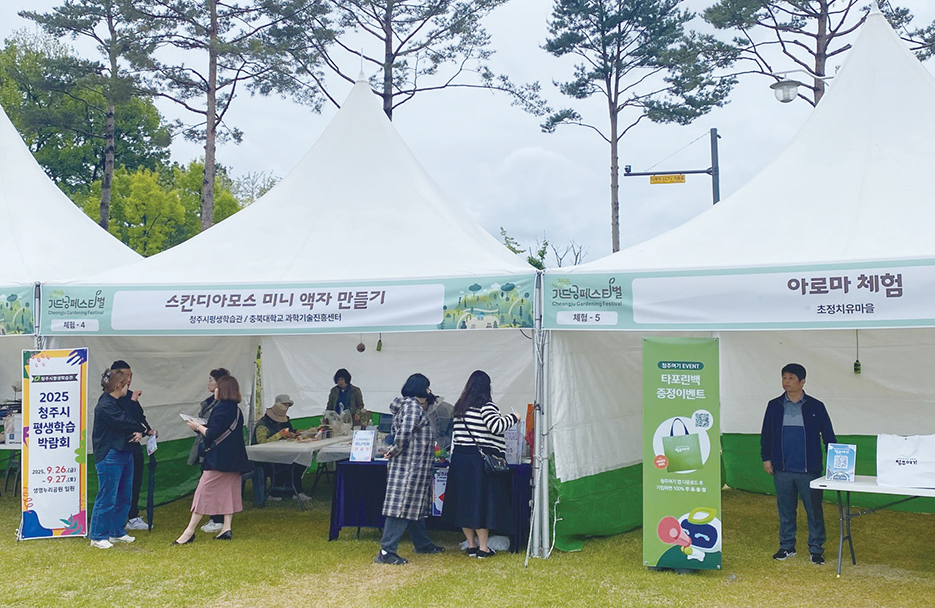The Chungbuk Times > Culture > View
Cheongju, Envisioning a City Through Gardens
제 222 호 발행일 : 2025.06.02

What Is the Cheongju Gardening Festival?
In the warm breeze of May, Cheongju Saengmyeongnuri Park was filled with vibrant gardens. From May 9 to 11, the Cheongju Gardening Festival offered citizens a unique opportunity to connect with nature in the heart of the city, engaging all five senses. Now in its ninth year — excluding a one-year break in 2020 due to the COVID-19 pandemic — the festival has become one of the Cheongju’s most beloved outdoor events.
This year’s theme, “Eolssu! Let’s All Play Together in the Garden of Seeds,” set the tone for a lively celebration where exhibitions, hands-on activities, and performances came together in a colorful and joyful atmosphere.

More than a Garden Exhibition: A Festival of Everyday Green
The Cheongju Gardening Festival goes beyond simply displaying gardens — its mission is to spread the culture of urban gardening and improve the quality of life for citizens. At the heart of the festival lies its core goal; making gardening culture more accessible to the public. By introducing gardens as a part of everyday life rather than as exclusive or inaccessible spaces, the festival encourages everyone to create and enjoy green spaces of their own.
This year’s event showcased garden works selected through a public competition, drawing attention from visitors throughout the park. Especially notable were the small-scale gardens designed by citizens, young people, and amateur creators, where natural aesthetics and everyday creativity came together — becoming popular photo spots for many.
On the lawn beside a garden booth, an elderly man gently held his granddaughter’s hand as they read a garden description together. “Let’s try something like this at home someday,” he whispered. She nodded quietly. In that moment, it was clear that gardens are not just about cultivating plants — they are about connecting generations and hearts. Scenes like these are what make the festival’s broader mission — expanding citizen participation in gardening — come to life. The festival is structured to welcome participation from all walks of life, offering public garden design contests, hands-on workshops, and educational booths that help promote a citizen-led gardening culture in Cheongju.
Without Participation, Gardens Cannot Sustain a City’s Culture
Despite collaborations with local small businesses, agricultural producers, and gardening-related industries, the Cheongju Gardening Festival continues to face a challenge; low levels of citizen engagement and limited participation from outside visitors. As a result, key components like the flea market and local tourism have not generated the expected economic benefits, limiting the festival’s potential as a catalyst for revitalizing the regional economy.
This lack of participation is especially concerning for a field like gardening, which — due to its expertise-driven and contemplative nature — relies more on active immersion than passive observation. When public interest wanes, garden culture risks becoming overlooked or undervalued, thereby weakening the festival’s fundamental mission of making gardening culture more mainstream. In the long term, there is growing concern that citizen-led gardening initiatives may fade into one-off events, undermining the sustainability of the festival itself.
In response to these concerns, the Cheongju Gardening Festival is now shifting toward a more strategic direction: strengthening citizen partnerships for sustainable cultural development. Efforts are underway to involve citizens, students, small business owners, and arts organizations not just as spectators, but as co-creators of the festival. By promoting a sense of shared ownership, the festival aims to transform low engagement into an opportunity — laying the groundwork for a community-based cultural infrastructure.
2025 Cheongju Gardening Festival: From Spectator to Participant
Garden exhibitions alone were not enough. The 2025 Cheongju Gardening Festival was packed with opportunities for visitors to actively take part in the experience. Starting with the opening ceremony on Friday, various hands-on programs were offered — such as Family Flowerpot Workshop and Moisture-Control Pot Making. On the weekend, special performances and activities for children added extra charm to the festivities.
A sudden spring rain in the afternoon did not deter the crowds. Families wearing raincoats remained at the class booths, while lines of children eagerly stepped in to participate. With the sound of raindrops as background music, the workshops took on an unexpectedly poetic atmosphere. The most popular attraction was the Scandia Moss Mini Frame booth.
Min Kyung-eun, a representative from CBNU Center for the Advancement of Science and Technology, led the workshop. “This program is part of a community science initiative supported by the Korea Foundation for the Advancement of Science and Creativity,” she explained. “We partnered with the Cheongju City Learning Center this year. Scandia moss is a great material — it feels nice to touch and works well in ecological education. Although the rain was unfortunate, I am grateful that many people still showed up consistently.”
To experience the activity firsthand, a CBT reporter joined one of the sessions. Upon sitting down, the soft colors of the moss immediately caught the eye. Guided by the instructor’s explanation, participants created their own mini garden frames using wooden bases and handfuls of colorful moss. It was more than just a craft class — it was a soothing, sensory experience that brought a sense of calm through touch and color.
Han Seung-joo, a visitor from Geumcheon-dong who joined the same session, shared, “A friend from Cheongju recommended the festival, and I honestly came just to enjoy the vibe. However, the workshops were way more fun than I expected. Especially the moss frame — it was refreshing and relaxing.”
Local Festivals, Global Potential: Cheongju’s Cultural Model
By 2025, the Cheongju Gardening Festival has firmly established itself as a leading example of how local, citizen-driven festivals can transcend mere exhibitions and tap into broader cultural and social potential. With gardening workshops for families, performances by local arts groups, and engaging programs for children, the festival stands out as a celebration where citizens are not just spectators — but active participants in shaping the event.
At the closing ceremony, the mayor of Cheongju emphasized the deeper purpose of the festival, stating, “As the largest garden festival in the central region, we hope it provides a safe and comforting space within the city — one where citizens can find healing for both body and mind.” He added, “The core goal of the festival is to spread garden culture and foster moments of restoration through interactions with nature, right in the heart of the urban landscape.”
Redrawing the City Through Gardens
On one side of the park, a flea market offered handcrafted flowerpots and artisan goods, lovingly arranged on tables. As visitors browsed, friendly conversations bloomed: “What is the name of this flower?,” “How often should I water it?” Laughter filled the air, blurring the line between buyer and seller, stranger and neighbor. The Cheongju Gardening Festival is more than a display of flowers and trees — it is a living dialogue between citizens and their city, using gardens as a medium for connection and understanding.
This festival is no longer about watching from the sidelines; it is about participating. It is no longer someone else’s event, but a shared project. A garden where citizens tend to their city together — that is the true message the Cheongju Gardening Festival hopes to share with its people.

By Kweon Sol-min
thfals7958@chungbuk.ac.kr